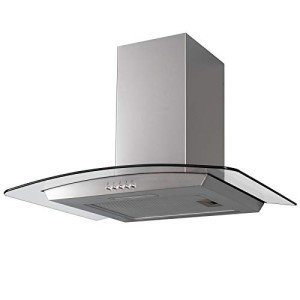
Kitchen Cooker Hood
FollowOverview
-
Founded Date 20 December 1958
-
Posted Jobs 0
-
Viewed 4
Company Description
5 Killer Quora Answers To Chimney Cooker Hoods
Understanding Chimney Cooker Hoods: A Comprehensive Guide
Chimney cooker hoods have actually become a staple in modern kitchens, merging functionality with elegant looks. These ventilation systems are designed to get rid of smoke, odors, and air-borne grease from the kitchen, enhancing air quality while complementing kitchen décor. In this blog post, we will check out numerous elements of chimney cooker hoods, their advantages, types, setup pointers, and upkeep recommendations.
What is a Chimney Cooker Hood?
A chimney cooker hood, typically called a chimney hood, is a kitchen device installed above the cooking range to extract smoke, grease, steam, and smells while cooking. Its style features a vertical structure resembling a chimney, providing it its name. These hoods can be ducted (venting air outside) or recirculating (filtering and reintroducing air), catering to varying kitchen setups.

Secret Features of Chimney Cooker Hoods
| Feature | Description |
|---|---|
| Style | Smooth and modern, fits numerous kitchen styles |
| Sizes | Readily available in multiple widths and heights |
| Filters | Usually geared up with grease and charcoal filters for optimum efficiency |
| Controls | May consist of buttons, touch, or push-button controls |
| Lighting | Functions integrated lighting for much better visibility while cooking |
Advantages of Using Chimney Cooker Hoods
-
Improved Air Quality: Chimney hoods effectively remove hazardous vapors, ensuring a much healthier cooking environment.
-
Smell Elimination: They help remove cooking smells, avoiding them from settling in furnishings or upholstery.
-
Grease Reduction: A chimney hood limitations grease accumulation on surface areas, making kitchen cleansing simpler.
-
Boosts Kitchen Aesthetics: Available in different styles, they can function as a focal point in kitchen design.
-
Increased Kitchen Comfort: By improving air blood circulation, they make cooking more pleasant, especially in restricted kitchen spaces.
Types of Chimney Cooker Hoods
Chimney hoods can be found in different types, each designed to match specific needs. Here are the most typical types:
| Type | Description | Pros | Cons |
|---|---|---|---|
| Wall-Mounted | Installed versus a wall above the cooking range. | Space-saving, trendy, and versatile. | Needs wall space; may be more costly. |
| Island | Suspended from the ceiling above an island cooking range. | Offers visual appeal and effective ventilation. | Setup can be intricate; higher expense. |
| Under-Cabinet | Installed under kitchen cabinets. | Suitable for kitchens with restricted space. | Less aesthetic appeal; may limit air flow. |
| Integrated | Integrated into kitchen cabinets for a seamless look. | Hidden style, takes full advantage of space. | Generally more costly; might restrict power. |
Installation Tips for Chimney Cooker Hoods
Setting up a chimney cooker hood [www.marquisimbriale.top] can be a straightforward procedure, however correct standards ought to be followed. Here is a list of important setup suggestions:
-
Select the Right Height: The perfect height for setup is generally in between 26-30 inches above the cooking surface.
-
Think about the Ductwork: Ensure adequate ducting remains in location if you opt for a ducted model. Brief, straight duct runs decrease loss of suction.
-
Validate Electrical Needs: Check the hood’s specifications for electrical requirements and make sure proper circuitry.
-
Follow Manufacturer Instructions: Each brand name might have unique treatments; always describe the maker’s guide.
-
Secure Proper Ventilation: Ensure proper ventilation outside the home for ducted hoods, preventing backdrafts.
Frequently Asked Questions About Chimney Cooker Hoods
1. How do I understand which size chimney hood to buy?To figure out the right size, consider the width of your cooking range. The hood ought to match or be a little larger than the cooking home appliance, usually 3-6 inches wider.
2. Do chimney hoods work without ducting?Yes, recirculating (non-ducted) designs can filter and purify the air before launching it back into the kitchen. However, they might be less reliable than ducted variations.
3. How frequently should I clean the filters?It’s a good idea to tidy grease filters monthly and change charcoal filters around every 6 months, depending on use.
4. Can chimney hoods be utilized over all kinds of cookers?Many models appropriate for gas and electrical cookers. Nevertheless, check the producer’s standards to make sure compatibility.
5. What is the typical cost of chimney cooker hoods?Costs vary significantly, ranging anywhere from ₤ 100 for basic designs to over ₤ 2,000 for high-end, designer versions.
Maintenance of Chimney Cooker Hoods
To make sure longevity and effective efficiency of chimney cooker hoods, routine maintenance is necessary. It can prevent breakdowns and keep optimum duct efficiency.
Maintenance Checklist
- Tidy the Filters: Remove and clean grease filters frequently.
- Check the Fan: Inspect and clean up the fan and motor to guarantee they function properly.
- Examine Ductwork: Periodically examine ducts for obstructions or buildup.
- Polish the Surface: Use suitable cleansing products to avoid scratches and keep shine on the outside.
- Evaluate the Lighting: Regularly examine light functions and replace burnt-out bulbs without delay.
Chimney cooker hoods are an essential part of modern kitchen style and functionality. They improve the cooking experience while effectively improving air quality. With numerous styles and alternatives available, finding the best chimney hood to fit your needs becomes an achievable job. By understanding their types, advantages, and upkeep, one can make informed decisions, guaranteeing a wonderfully ventilated kitchen for many years to come.



